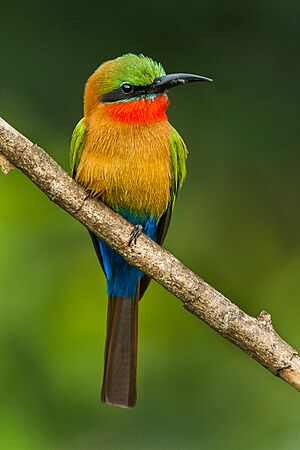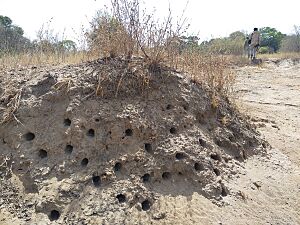Red-throated bee-eater facts for kids
Quick facts for kids Red-throated bee-eater |
|
|---|---|
 |
|
| Conservation status | |
| Scientific classification | |
| Genus: |
Merops
|
| Species: |
bulocki
|
The red-throated bee-eater (Merops bulocki) is a colorful bird from the Meropidae family. These birds live in warm, tropical parts of Africa. You can find them in countries like Benin, Burkina Faso, Cameroon, and many others across the continent.
This bird species has a very large population. They also live in a wide area. Because of this, the International Union for Conservation of Nature says they are a "least concern" species. This means they are not currently in danger of disappearing.
What Does the Red-Throated Bee-Eater Look Like?
Adult red-throated bee-eaters are about 20 to 22 cm (8 to 9 in) long. This includes their tail, which is not too long. Their upper body is green. They have a bright red chin and throat, which makes them easy to spot!
However, about 1% of these birds have a yellow throat instead of red. Their neck, chest, and belly are a light brown color. The feathers under their tail and on their thighs are a bright blue. Birds living in the eastern part of Africa have blue faces. Those in the west have green faces.
Where Do Red-Throated Bee-Eaters Live?
The red-throated bee-eater lives all over tropical Africa. Their home stretches from Senegal in the west to Ethiopia in the east. They like to live in savannah areas with scattered trees. You can also find them in farmlands with trees, near marshes, and in gardens.
These birds usually stay close to water. They like to be near small rivers, streams, and erosion gullies. This is because they build their nests in the banks of these waterways.
Life and Habits of the Red-Throated Bee-Eater
Red-throated bee-eaters are very social birds. They live and nest in large groups called colonies. They stay in their nesting areas all year long.
They dig tunnels in the ground for their nests. They do this before the ground gets too dry after the rainy season. A single colony can have up to fifty nests!
These birds mostly eat honey-bees and stingless bees. They also eat other kinds of insects. When they are looking for food, a pair or a small group will fly around together. Sometimes, you can even see several of them perched in a neat row side by side.



